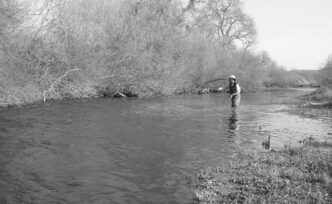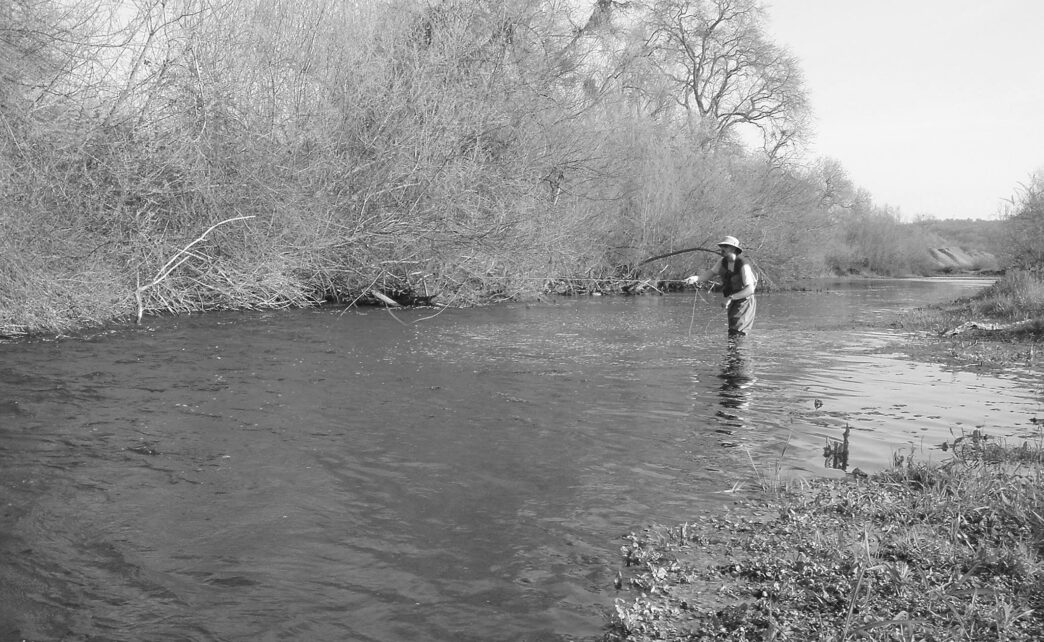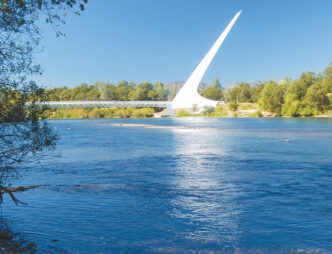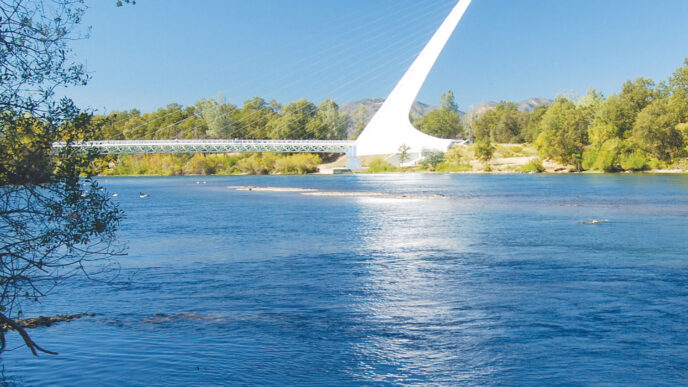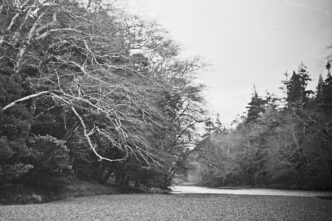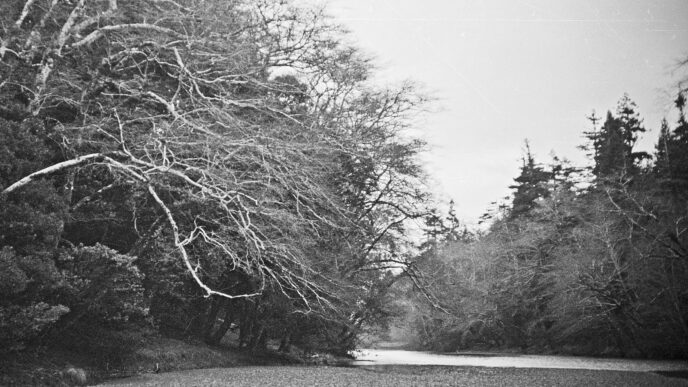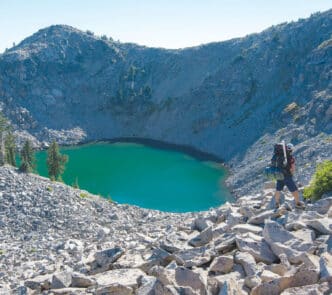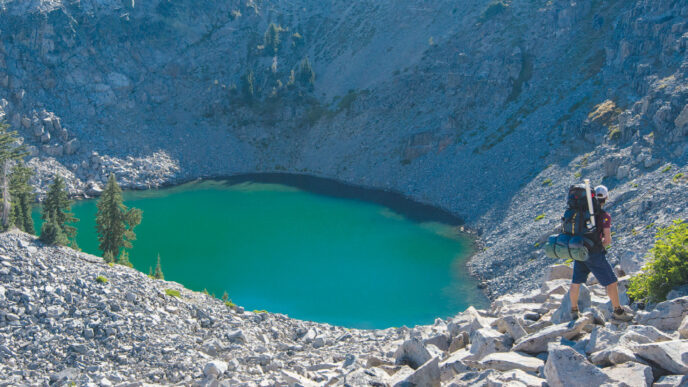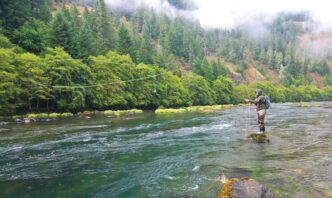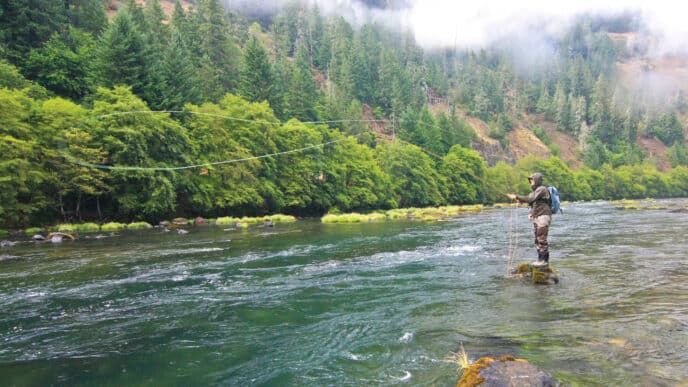Wading a river is effective, but floating a river is enthralling. To float a river is to fish it in style and comfort. You can bring lots of gear, access areas that wading anglers can’t reach, and see some great scenery along the way. A successful float trip also requires practicing ancient skills: navigation, map reading, rowing, and paddling. The idea of floating a river is irresistible to most anglers.
Many satisfy their desire to float their local rivers by purchasing a pontoon boat or some other sort of one-person watercraft. But there are some things to consider about buying such a craft or using the one you already own. In addition, there are factors to consider when deciding where best to use such craft. The rivers in California’s Central Valley lowlands offer countless river miles to float and explore in boats like these, and I’ll discuss the opportunities these rivers offer and how best to take advantage of them.
Pontoon Boats and Beyond
The pontoon boat is the poster child for one-person watercraft. Most have two somewhat banana-shaped pontoons that are joined by a hard or soft frame. The pontoons are typically 8 to 10 feet in length. They come with a pair of oars and are meant to be rowed like a drift boat, and they can be used in moving water, not just on lakes. These boats can carry a lot of extra gear, and accessories include anchor systems, rod holders, ice chests, fish finders, electric motors, and even small gas motors. I recommend keeping it simple for starters, though. You have to row all that stuff around all day, so keep things as light as possible.
Some of the larger float tubes are also marketed for use in moving water. These tubes have a U shape, with the tube wrapping around your backside, leaving the front open. Many of the pontoon boat models now sport this U shape, as well. Like pontoon boats, this type of tube comes with oars. In fact, it’s getting hard to tell the small pontoon boats and large float tubes apart. (Standard donut-shaped float tubes should not be used on moving water, given the difficulty of getting out of them if you run into trouble.)
But there are other choices in oneperson watercraft. Inflatable kayaks make great one-person fishing vessels. Inflatable kayaks come in one-person and two-person versions, but the two-person versions are also excellent for a single angler, because they allow a lot of extra room for gear. The biggest consideration with an inflatable kayak is that you need to paddle it like a canoe, which is a totally different skill set from rowing with two oars.
There is another category of one-person craft that is a hybrid between a kayak and a pontoon boat. The Outcast Commander is an example. I’ll call these “kayak hybrids.” These boats are shaped like a one-person kayak, but have built-in oars, so you row them like a pontoon boat or a drift boat.
Whatever watercraft you choose for floating rivers, think carefully about how it will perform, and how you will escape from it, if you encounter difficult or otherwise unsafe conditions.
Features to Consider
As you might expect, there are pros and cons that characterize each type of one-person watercraft and the design features that differentiate them. What’s a pro and what’s a con depends on the waters you’ll be floating and the uses to which you intend to put one of these boats.
Some one-person craft allow the operator to navigate using fins (flippers), and some don’t. The benefit of propelling a craft by kicking along using fins is that you can both control the boat and fish at the same time. This feature comes into play on larger rivers, such as the lower Sacramento, Yuba, Feather, and American, and is less useful on smaller rivers. Smaller rivers lend themselves to wade fishing, so you can use your boat more like a taxi cab and not worry about trying to fish while on the move.
If you do want to fin kick, look for fins that are made for this purpose, as opposed to regular scuba fins. Fin-kicking models have an elevated fin that allows for wading and walking. Pontoon boats, float tubes, and kayak hybrids all have open floors that allow for fin kicking. Inflatable kayaks do not.
Oars are another common way to propel pontoon boats, and oars can be troublesome. They can pop out, and oarlocks can tangle fly lines. Most of the newer models have oars that firmly lock into place, which is good. If your oars easily pop out of the holders, make sure you attach them with a tether of some sort, so you don’t lose them overboard.
Some of the larger pontoon boats can be fitted with an anchor system. These systems typically involve a pulley, a rope snugger, and then a rope with a five-pound lead weight. In my experience, these anchors perform much better on lakes than on moving water.
A more useful feature found on most one-person craft is an enclosed, but open floor that allows the angler to stand up and wade fish without getting out of the boat. The hybrid kayaks have this feature. Pontoon boats and U-shaped float tubes can be modified by tying a strap across the pontoons in front of your legs. Inflatable kayaks have solid floors. If you want to hold on to your inflatable kayak while wading shallow water, simply tie a leash of some sort to the boat and to your belt.
Some of the larger pontoon boats come with standing platforms and lean bars. With them, you can anchor in water that is too deep to wade, then stand up and fish. This feature may sound enticing, but it’s not necessary on Central Valley rivers.
The first generation of pontoon boats had heavy, rigid metal frames that made them difficult to store and to transport. The newer boats have frames that are easy to collapse. Many of the new pontoon boats and kayak hybrids have “soft” frames, with no rigid parts at all. These boats are much easier to store and to transport. Similarly, inflatable kayaks can simply be deflated and rolled up. But keep in mind that all of the accessories take up a lot of room.
Pontoon boats, kayak hybrids, and one-person inflatable kayaks all perform well in white water. Float-tube style craft are more suitable to Class I rivers. Two-person inflatable kayaks are so long that they’re hard for one person to control once you get into Class II water.
Prime Areas to Explore
Whatever one-person watercraft you choose, some of the best “starter” floats are to be found on the lower Sacramento, Yuba, and American Rivers. These are all large rivers with plenty of room to maneuver and have excellent wade fishing. On the lower Sac, try floating from the Posse Grounds in Redding to the Bonnyview boat ramp or from the Bonnyview boat ramp to the Anderson River Park boat ramp. (And see “Wading the Lower Sacramento: New Trails Open Up More Stretches,” by Bob Madgic, in this issue.) Make sure flows are below 7,000 cubic feet per second if you plan on doing any wading on the lower Sac. On the Yuba, there is a great float from the Highway 20 bridge to the Hammond Grove river access. The American River has many access points that can be used as put-ins and take-outs. Contact local fly shops for information about the best time of year to go. Fly-fishing clubs are also a great resource for information on floating these rivers.
If you want to try fin kicking, the lower Sacramento is probably the best choice. When flows are in the range of 10,000 to 15,000 cfs during the summer months, some adventurous pontoon boaters float 15 miles of river in a day. They fin kick to steer the boat and fish on the move.
Scouting Potential Floats
Among the advantages that one-person watercraft bring you is the ability to access waters that otherwise are inaccessible to shorebound anglers, and they allow you to plan and execute fishing trips that previously you couldn’t imagine. I’ve had excellent one-person fly-fishing float trips on all of the Central Valley rivers, from the lower Sacramento in Redding down to the Kings River near Fresno. All of these rivers are tailwaters, meaning they issue forth from the bottom of a large dam. The tailwater stretches of these rivers all have trout, and some even have seasonal runs of steelhead. The lower reaches of these rivers also hold smallmouth bass, and some have stripers, too.

All it takes to figure out a workable plan for floating the Central Valley rivers is a little research. I usually start my research by identifying a suitable river system using a DeLorme California Atlas and Gazetteer, then I switch over to Google Earth for more detail. Look for potential put-ins and take-outs. Use the trace tool in Google Earth to follow the river to see the actual distance in river miles between put-in and take-out. It may be much longer than you think. Don’t bite off more than you can chew. Start with floats in the three-to-four-mile range. As a general rule, a river flows at about three miles per hour. Keep in mind all the time you’ll spend angling. It’s easy to spend an entire day on a three-mile float. Most, but not all the floats on Central Valley rivers are devoid of white water. White water can be fun, but on your first few trips, you should stick to Class I water and then maybe try some Class II water. Class I water is moving water with riffles and small waves. Class II water has rapids that may require some maneuvering, but they have an obvious safe path and do not require scouting.
A great way to find out if there is any significant white water your float is to consult some kayaking Web sites. A quick look through http://www.californiawhitewater.com, http://www.cacreeks.com, and the California page on http://www.americanwhitewater.org should give you an idea about your float. If the stretch you plan to float is not listed, it’s going to be in the Class I to Class II range. Class III rapids are not to be fooled with lightly. When you are an experienced oarsman or paddler and know your watercraft inside and out, you can consider running Class III rapids.
Always have a backup float plan in case your first idea doesn’t pan out. Many times, I’ve arrived at a bridge that I planned to use as a put-in, only to find that there is no parking or river access. You may need to drive around a bit to find an alternative launch point.
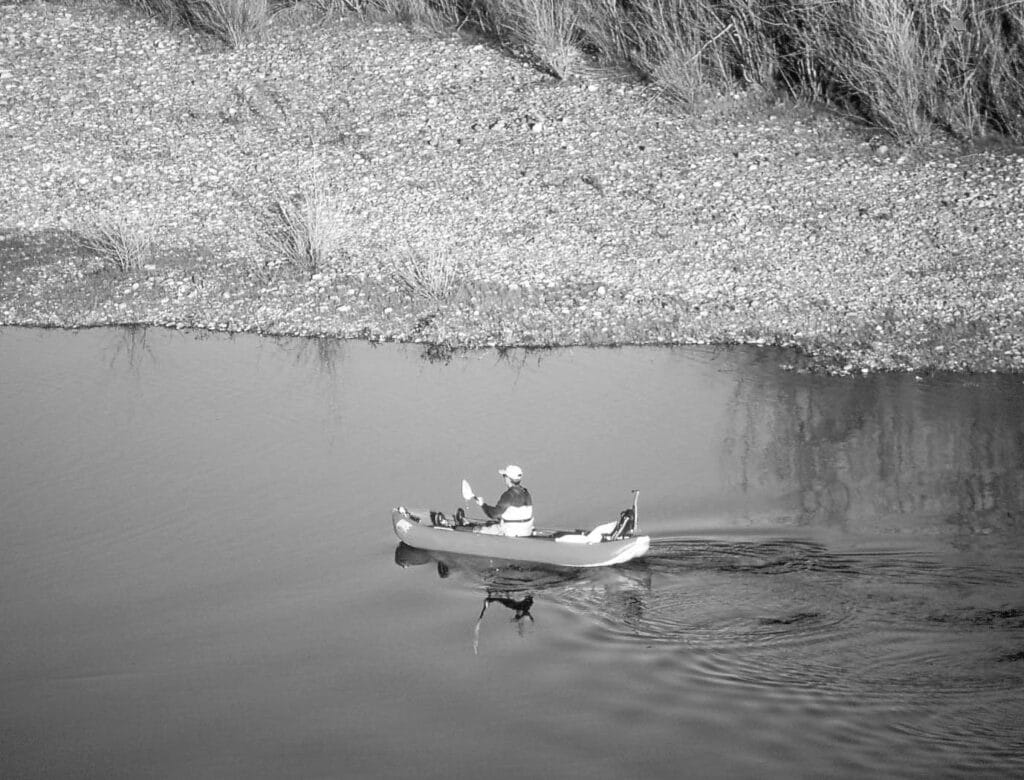
Regulations
Many of California’s Central Valley rivers have seasonal migrations of salmon and steelhead. The presence of these fish complicates the fishing regulations. Some of these rivers have a seasonal closure in November and December to protect spawning salmon. There is little consistency between the regulations for Central Valley rivers. For example, the Mokelumne River is open from January 1 to October 15, but the nearby Stanislaus River is open from January 1 to October 31. Make sure you consult your book of fishing regulations before heading out.
Hazards and Safety Practices
There is a lot that can go wrong when you’re floating a river. Unfortunately, floating anglers tend to treat the river with much less respect than other river users. Avoid complacency. Something as simple as losing an oar when you’re upstream from a tree fallen in the water can lead to disaster or even death. Get off to a good start by wearing a personal floatation device (PFD). Don’t skimp — get one like the kayakers use. A quality PFD is compact, gives you plenty of room around the shoulders, and will last for many years.
The biggest hazards I’ve encountered on Central Valley rivers are log jams, diversion dams, and sweepers. A sweeper is any sort of obstruction sticking out from the bank (usually a downed tree) with water flowing through it. If you run into a sweeper, your craft will get stuck and possibly capsize. The most dangerous sweepers are on the faster rivers, such as the lower Sac and the Feather River. Give all sweepers a wide berth.
When rowing to maneuver, you should always pull on the oars and move your craft backward, angling away from any hazards. This approach gives you more time than if you were to point the boat in a safe direction and push on the oars to paddle forward.
Always bring some extra rope and cam straps. They will be useful when portaging around small dams and log jams. Also pack a patch kit and a pump. Most manufacturers have an online video showing how to patch their craft. Watch it before you go. Even if you don’t get a puncture, it’s good to have a pump to keep your boat fully inflated throughout the day.
Shuttles
The final riddle to solve once you are ready for your first adventure in your one-person watercraft involves logistics. If you launch your boat in one spot and beach it miles downstream, how do you get back to your car from where you end up? Here is a quick rundown of the options.
In an ideal world, every river would have a shuttle service. As it happens, the only Central Valley river with a reliable shuttle service is the lower Sacramento. The Fly Shop in Redding offers a shuttle service almost every day of the year. Shuttles range in price from $25 to $50, depending on the float. At times, there have been shuttle services on the Feather, Yuba, and American Rivers, but they seem to be as ephemeral as our beloved mayflies.
Since shuttle services are very rare, the next best option is to find a friend who also has a one-person boat. And a car. Or, better yet, a truck or SUV. Load both boats in car number 1 and drive both cars to the take-out. Drop car number 2 there. Drive upstream to the put-in, launch the boats, make sure you have the keys to car number 2 on your person, float the river, and end up at car number 2. Load the boats into car number 2 and drive upstream to retrieve car number 1. It seems wasteful to have to drive two cars, but it’s also much safer to float a river with another person.
You may also be able to finagle a friend or relative to help you with your shuttle. You could load your boat into their vehicle, leave your vehicle at the take-out, and have them drive you up to the put-in. Again, make sure the keys to your vehicle are on your person before you launch your boat and wave goodbye to your shuttle bunny.
Another time-honored option is the bicycle shuttle. If your shuttle is relatively short and does not involve freeway driving, this can work well. You will need a bike that no one will want to steal and room in your car to transport both the bike and the boat. Lock up the bike at the take-out and hope it’s still there when you’re done with your float. You can also do this in reverse and get the bike ride out of the way in the morning. Then you can spend all day hoping your car is still at the take-out. You might be picking up some subtle hints here about vehicle security. A gravel bar on the lower Feather River or a narrow roadside pullout next to the Stanislaus River can be a worrisome place to your leave your vehicle all day. About all you can do is remove any valuables from the vehicle and hope for the best. These are the risks you take if you want to explore the inaccessible riffles and runs of some of our
best Central Valley rivers. I recommend using a GPS when running your shuttle. Cell phone coverage is pretty good on many Central Valley rivers, so you may be able to use your map app and GPS on your smartphone. Mark a waypoint at the take-out. During your float, you can then check and see how far you are from the take-out. Getting to the take-out after dark should be avoided at all costs. And when you drop off your shuttle vehicle at the take-out, take a look around and make sure you know what the takeout looks like from the river. It’s no fun to be near the end of your float and not remember what the take-out looks like.



